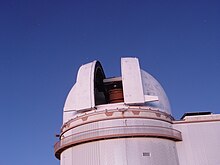UH88

UH88 at sunset
|
|
| Coordinates | 19°49′23″N 155°28′12″W / 19.8231°N 155.47°WCoordinates: 19°49′23″N 155°28′12″W / 19.8231°N 155.47°W |
|---|---|
| Telescope style |
optical telescope |
| Website | www |
|
|
|
|
[]
|
|
The University of Hawai'i 88-inch (2.2-meter) telescope called UH88, UH2.2, or simply 88 by members of the local astronomical community is situated at the Mauna Kea Observatories and operated by the University's Institute for Astronomy. It was constructed in 1968, and entered service in 1970, at which point it was known as "The Mauna Kea Observatory." It became one of the first professional telescope to be controlled by a computer. The telescope was built with funding from NASA, to support Solar System missions and is controlled by the University of Hawai'i. The success of the telescope helped demonstrate the value of Mauna Kea for astronomical observations.
On December 4, 1984 it became the first telescope to make optical closure phase measurements on an astronomical source using an aperture mask.
UH88 is a Cassegrain reflector tube telescope with an f/10 focal ratio, supported by a large open fork equatorial mount. It was the last telescope on Mauna Kea to use a tube design rather than an open truss, and is the largest in the complex to use an open fork mount, with neighboring telescopes in the 3-meter class using English fork designs.
As the only research telescope controlled solely by the University, UH88 has long been the primary telescope used by its professors, postdoctoral scholars and graduate students, and as a result, the site of numerous discoveries. David C. Jewitt and Jane X. Luu discovered the first Kuiper belt object,1992 QB1 using UH88, and a team led by Jewitt and Scott S. Sheppard discovered 45 of the known moons of Jupiter, as well as moons of Saturn, Uranus and Neptune.
...
Wikipedia
